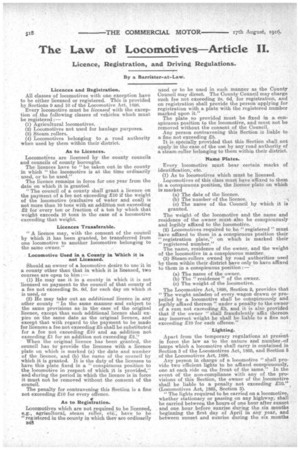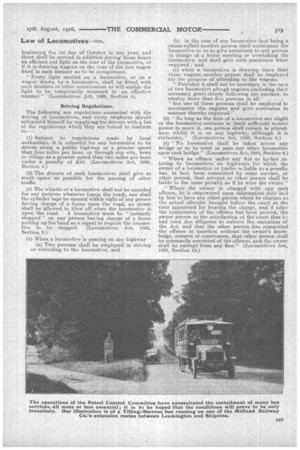The Law of Locomotives Article IL
Page 16

Page 17

If you've noticed an error in this article please click here to report it so we can fix it.
Licence, Registration, and Driving Regulations.
By a Barrister-,at-Law.
Licences and Registration.
All classes of locomotives with one exception have to be either licensed or registered. This is provided. by Sections 9 and 10 of the Locomotive Act, 1898. Every locomotive must be licensed with the exception of the following classes of vehicles which must be registered :—
(1) 'Agricultural locomotives. (2) Locomotives not used for haulage purposes. (3) Steam rollers. (4) Locomotives belonging to a road authority when used by them within their district.
As to Licences.
Locomotives are licensed by the county councils and councils of county boroughs.
The licences have to "be taken out in the county in which "the locomotive is at the time ordinarily used, or to be used."
The licence O i remains in force for one year from the date n which it s. granted. "The council of a county shall grant a licence on the payment of a fee not exceeding 210 if the weight of the locomotive (exclusive of water and coal) is not more than 10 tom with an addition not exceeding £2 for every ton or fraction of a ton by which that weight exceeds 10 tons in the case of a locomotive exceeding that weight.
• Licences Transferable.
"A licence may, with the consent of the council by which it has been granted, be transferred from one locomotive to another locomotive belonging to the same owner."
• Locomotive Used in a County in Which it is not Licensed.
Should an owner of a locomotive desire to use it in a county other than that in which it is licensed, two courses are open to him
(1) He may use it in a county in which it is not licensed on payment to the council of that county of a fee not exceeding 2s. 6d. for each day on which it is used, or (2) He may take out an additional licence in any
other county "In the same mannerand subject to the same provisions as in the case of the original licence, except, that such additional licence shall expire on the same date as the original licence, and except that with regard to the payment to be made for licences a fee not exceeding 25 shall be substituted for a fee not exceeding £10 and an addition not exceeding £1 for an addition not exceeding 22.-" When the original licence has been granted, the council has to provide the licensee with a, licence plate on which is marked (a) the date and number of the licence, and (b) the name of the council by which it is granted. It is the duty of the licensee to have this plate fixed in a "conspicuous position to the locomotive in respect of which it is provided," and during the period in which the licence is in force it must not be removed without the consent of the council.
The penalty for contravening this Section is a fine not exceeding 210 for every offence.
As to Registration.
Locomotives which are not required to be licensed, e.g., agricultural, steam roller, etc., have, to be "registered in the county in which they are ordinarily used or to be used in such manner as the County Council may direct. The County Council may charge such fee not exceeding 2s. 6d. for registration, and on registration shall provide the person applying for registration with a plate with the registered number marked upon it." The plate so provided must be faxed in a conspicuous position to the locomotive, and must not be removed without the consent of the Council.
Any person contravening this Section is liable to a fine not exceeding 25. It is specially provided that this Section shall not apply in the case of the use by any road authority of a steam-roller belonging to them within their district.
Name Plates.
Every, locomotive must bear certain marks of identification,etc.
(1) As to locomotives which must be licensed.
Locomotives of this class must have affixed to them in a conspicuous position, the licence plate on which is marked (a) The date of the licence.
(b) The number of the licence.
(c) The name of the Council by which it is granted.
The weight of the locomotive and the name and residence of the owner mustalso be conspicuously and legibly affixed to the locomotive.
(2) Locomotives required to be " registered " must have affixed to them in a conspicuous position their "registration plate," on which is marked their " registered number." The name, residence of the owner, and the weight of the locomotive in a. conspicuous manlier.
(3) Steam-rollers owned by road authorities used by them within their district have only to have affixed to them in a conspieuousposition (a) The name of the owner. (b) The cf residence" of the owner. (c) The weight of the locomotive.
The Locomotive Act, 1898, Section 2, provides that "The weight unladen of every wagon drawn or propelled by a locomotive shall be conspicuously and legibly affixed thereon" under a penalty to the owner of a sum not exceeding 25, and it is also provided that if the owner "shall fraudulently affix thereon any incorrect weight he shall be liable to a fine not exceeding 210 for each offence."
Lighting.
Apart from the temporary regulations at present in force the law as to the nature and number...Of lamps which a locomotive shall carry is contained in Section 3 of the Locomotives Act, 1865, and Section 5 Of the Locomotives Act, 1898.
Any person in charge of a locomotive "shall provide two efficient lights to be affixed conspicuously, one at each side on the front of the same.' In the event of the non-compliance with any of the provisions of this Section, the owner of the locomotive shall be liable to a penalty not exceeding £10." (Locomotives Act, 1865, Section 3).
"The lights required to be carried on a locomotive, whether stationary or passing on any highway, shall be carried between the hours. of one hour after sunset and one hour, before sunrise during the .six months beginning the first day of April in any year, and between sunset and sunrise during the six months
beginning the 1st day of October in any year, and i there shall be carried n addition during those hours an efficient red light on the rear of the locomotive, or if it is drawing wagons on the rear of the last wagon fixed in such manner as to be conspicuous.
" Every light carried ona locomotive, or on a wagon drawn by a locomotive, shall be fitted with such shutters or other contrivances as will enable the light to be temporarily screened in an effective manner." (Locomotives Act, 1808, Section 5).
Driving Regulations.
The following are regulations. connected with the driving of locomotives, and every employer should safeguard himself by supplying-his drivers with a list of the regulations which they are bound to conform to : (1) Subject to regulations made by local authorities, it is unlawful for any locomotive to be driven along a public highway at a greater speed than four miles per hour, or through any city, town or village at a greater speed than two miles. per hour under a penalty of 210. (Locomotives. Act, 1865, Section 4.)
(2) The drivers of such locomotives shall give as much space as possible for the passing, of other traffic.
(3) The whistle of a locomotive shall not be sounded for any purpose whatever (upon the road), nor shall the cylinder taps be opened within sight of any person having charge of a horse upon the road, no steam shall be allowed to blow, off when the locomotive is upon the road. A locomotive must be "instantly stopped" on any person having charge of a horse putting up his hand, as a signal to require the locomotive to be stopped. (Locomotives Act, 1865, Section 3.)
(4) When a locomotive is passing on any highway • (a) Two persons shall be employed in driving or attending to the locomotive, and
(b) in the ease of any locomotive (not being a steam-roller) another person shall accompany the locomotive so as to giveassistance to any-person in charge of a horse meeting or overtaking the locomotive, and shall give such assistance when required; and
(c) when a locomotive is drawing more than three wagons .another person shall be employed for the purpose of attending to the wagons.
"Provided it shall not be necessary in the case of two locomotive plough engines (including their necessary gear) closely following one another, to employ more than five persons in all"
"but one of these persons shall be employed to accompany the engines and give assistance in manner thereby required." .
(5) " So long as the fires of a locomotive are alight. or the locomotive contains in itself sufficient motivepower to move it, one person shall remain in attendance whilst it is on any highway, although it is stationary." (Locomotives Act, 1898, Section 5.) • (6) " No locomotive shallbe taken across any bridge so as to meet or pass any other locomotive upon such bridge." (Locomotives Act, 1898, Section 8.) "Where an offence under any Act or by-law .re, lating to locomotives on •highways for which the owner of a locomotive or trailer is liable to a penalty has, in fact, been committed by some servant, or other person, that servant or other person shall be liable to the same penalty. as if he were the owner."
" Where the owner is charged with any such offence, he is empowered upon information duty laid by him to have any other person whom he charges as the actual offender brought before the court at the time appointed for hearing the charge, and if alter the commission of the offence has been proved, the owner proves to the satisfaction of the court that Im had used due diligence to enforce the execution of the Act, and that the other person has committed the offence in question without the owner's knowledge, consent or connivance, that other person shall be summarily convicted of the offence, and the owner shall be exempt from any fine." (Locomotives Act, 1898, Section 13.)




















